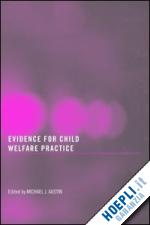1. Introduction Michael J. Austin PART I: EVIDENCE FOR DIRECT PRACTICE ASSESSMENT IN CHILD WELFARE 2. Understanding and Addressing Racial/Ethnic Disproportionality in the Front End of the Child Welfare System Kathy Lemon Osterling, Amy D’Andrade, Michael J. Austin 3. Risk and Safety Assessment in Child Welfare: Instrument Comparisons Amy D’Andrade, Michael J. Austin, Amy Benton 4. Family Assessment in Child Welfare Services: Instrument Comparisons Michelle A. Johnson, Susan Stone, Christine Lou, Catherine M. Vu, Jennifer Ling, Paola Mizrahi, Michael J. Austin 5. Assessing Child and Youth Well-Being: Implications for Child Welfare Practice Christine Lou, Elizabeth K. Anthony, Susan Stone, Catherine M. Vu, Michael J. Austin CHILD WELFARE OUTCOMES 6. Understanding and Measuring Child Welfare Outcomes Amy D’Andrade, Kathy Lemon Osterling, Michael J. Austin 7. Substance Abuse Interventions for Parents Involved in the Child Welfare System: Evidence and Implications Kathy Lemon Osterling, Michael J. Austin 8. Assessing Parent Education Programs for Families Involved with Child Welfare Services: Evidence and Implications Michelle A. Johnson, Susan Stone, Christine Lou, Jennifer Ling, Jennette Claassen, Michael J. Austin PART II: EVIDENCE FOR MANAGEMENT PRACTICE 9. Evidence-Based Practice in the Social Services: Implications for Organizational Change Michelle Johnson, Michael J. Austin 10. Implementing Evidence-Based Practice in Human Service Organizations: Preliminary Lessons from the Frontlines Michael J. Austin, Jennette Claassen 11. The Dissemination and Utilization of Research for Promoting Evidence-Based Practice Kathy Lemon Osterling, Michael J. Austin 12. Impact of Organizational Change on Organizational Culture: Implications for Introducing Evidence-Based Practice Michael J. Austin, Jennette Claassen 13. Knowledge Management: Implications for Human Service Organizations Michael J. Austin, Jennette Claassen, Catherine M. Vu, Paola Mizrahi












